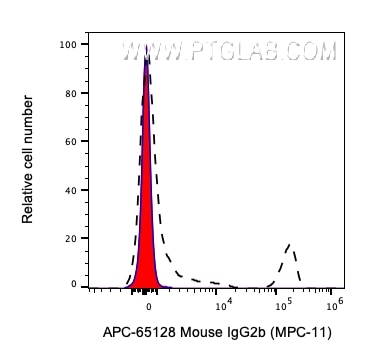Tested Applications
| Positive FC detected in | human PBMCs |
Recommended dilution
| Application | Dilution |
|---|---|
| Flow Cytometry (FC) | FC : 0.2 ug per 10^6 cells in 100 μl suspension |
| This reagent has been tested for flow cytometric analysis. It is recommended that this reagent should be titrated in each testing system to obtain optimal results. | |
| Sample-dependent, Check data in validation data gallery. | |
Published Applications
| FC | See 3 publications below |
Product Information
APC-65128 targets IgG2b Isotype Control in FC applications and shows reactivity with n/a samples.
| Tested Reactivity | n/a |
| Host / Isotype | Mouse / IgG2b, kappa |
| Class | Monoclonal |
| Type | Antibody |
| Immunogen |
fusion protein Predict reactive species |
| Full Name | immunoglobulin heavy chain 3 (serum IgG2b) |
| Gene Symbol | IgG2b Isotype Control |
| Gene ID (NCBI) | 16016 |
| RRID | AB_2883011 |
| Conjugate | APC Fluorescent Dye |
| Excitation/Emission Maxima Wavelengths | 650 nm / 660 nm |
| Form | Liquid |
| Purification Method | Affinity purification |
| UNIPROT ID | P01867 |
| Storage Buffer | PBS with 0.09% sodium azide and 0.5% BSA, pH 7.3. |
| Storage Conditions | Store at 2-8°C. Avoid exposure to light. Stable for one year after shipment. |
Background Information
The MPC-11 immunoglobulin is useful as an isotype-matched control. The MPC-11 immunoglobulin has an unknown binding specificity and is used as an isotype control for mouse IgG2b antibodies. This antibody has been quality-tested for flow cytometry as negative control.
Protocols
| Product Specific Protocols | |
|---|---|
| FC protocol for APC IgG2b Isotype Control antibody APC-65128 | Download protocol |
| Standard Protocols | |
|---|---|
| Click here to view our Standard Protocols |
Publications
| Species | Application | Title |
|---|---|---|
MedComm (2020) CircMALAT1 promotes cancer stem-like properties and chemoresistance via regulating Musashi-2/c-Myc axis in esophageal squamous cell carcinoma | ||
Adv Mater An OMV-Based Nanovaccine as Antigen Presentation Signal Enhancer for Cancer Immunotherapy | ||
Eur J Pharmacol PPARγ agonist pioglitazone enhances colorectal cancer immunotherapy by inducing PD-L1 autophagic degradation | ||
Auris Nasus Larynx Simultaneous disturbance of NHE1 and LOXL2 decreases tumorigenicity of head and neck squamous cell carcinoma |




